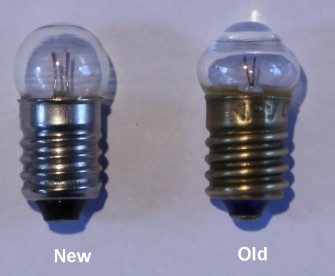Julian Thornton recently wrote to me about his newly acquired Freiberger Trommelsextant , asking about a fitting attached to the outside of the micrometer mechanism. He was able to de-construct it to get it working and kindly agreed to write a guest post. This is what he wrote (I have added comments in blue):
I bought a used Freiberger Trommel sextant on eBay and when it arrived it had an attachment on the micrometer drum (Figure 1)

Figure 1: Lighting unit as found.
At first I didn’t know what this was (this was my first sextant) but eventually worked out that it was a lighting unit. It didn’t work so I decided to take it apart. An exploded view of the disassembled lighting unit is shown below (Figure 2). This figure can be enlarged by double clicking on it. Use the back arrow to return to the text.
The frame of the unit wraps around the micrometer housing of the sextant and is held in place by a thumb screw (see also Figure 4). The bulb screws into the bulb housing.The contact rod is insulated from the bulb housing by the insulating bush. The bush screws into the other end of the bulb housing. A screw passes through the switch arm into the end of the contact rod. The other end of the switch arm is secured by a screw which passes through an insulating bush into the right hand end of the battery housing to make contact with the battery. When bulb end of the arm is depressed, the end of the contact rod makes contact with the central contact of the bulb. The circuit is completed via the spring, cap, battery housing, frame and bulb housing into which the bulb screws.
This unit would not be too difficult to reproduce in a well-equipped home workshop. I may try to do so when I run out of other things to do...
The first thing I did was put a new AA battery in it but it still didn’t work. I inspected the bulb but I couldn’t see a filament, but as I didn’t have a circuit tester with me I could not test its continuity. On the side of the bulb it said 1.5v 0.2A so I looked online and found that E10 1.5v 0.3A bulbs are pretty common so I bought some. I also noticed that the original bulb appeared to have thicker glass of the top than the sides, almost as if it were a crude lens, see bulb on the right in the picture below (Figure 3).

Figure 3: New and old bulbs.
The old bulb with its lens is called a pre-focus bulb
I emailed Freiberger in Germany to ask about the bulb and ask if they sold spare bulbs. They confirmed that the bulb does indeed have a thicker end than sides but that they do not sell spares of any type for the illuminator mechanism, but that I could buy a complete new unit for €136 plus postage and packing. They said that a standard E10 1.5v bulb would work fine. I then cleaned up all the contacts and reassembled the unit with the original bulb. The light came on immediately and the unit worked well with the on / off function provided by pushing the metal screw at the end of the lamp assembly which then makes the electrical circuit, see LHS of end view below, Figure 4. The natural tension of the metal plate connecting the battery and lamp assemblies then moves the screw away thus breaking the electrical circuit.
This photo also makes clear how the unit is attached to the sextant.

Figure 4: End view of switch.
When the new bulbs arrived I inserted one and it came on immediately but the only way I could turn it off was to remove the battery. On further examination of the new and old bulbs I noticed that the new bulb was fractionally longer so I filed down the contact end of the bulb with emery paper and re installed it. The unit then worked properly. The new bulb is rated at 0.3A so in fact is a 50% higher power rating than the original bulb and is a noticeable improvement.
Thank you, Julian.

Leave a comment